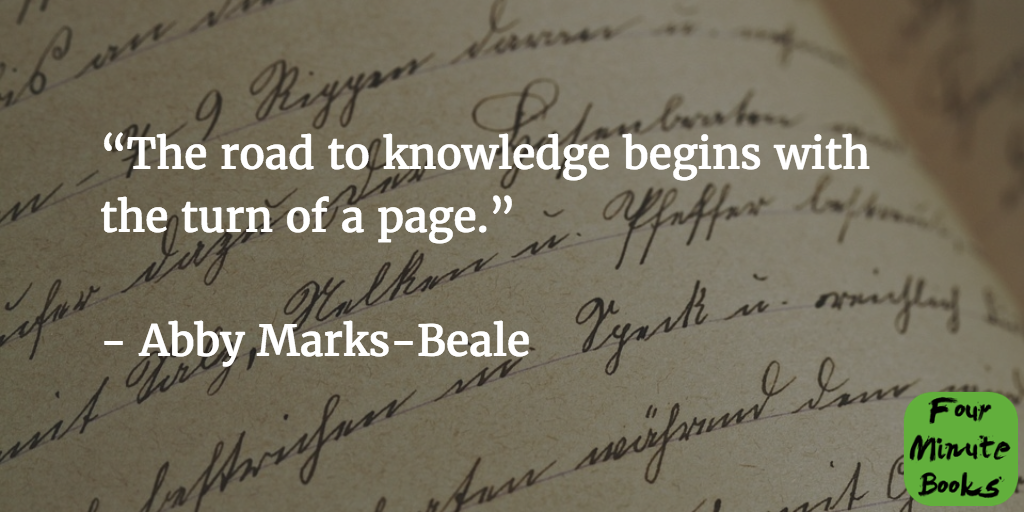1-Sentence-Summary: 10 Days To Faster Reading helps you bring your reading skills to the current century, even if you’ve stopped developing them, like most of us, with the end of elementary school, by helping you select what to read in a better way and giving you actionable techniques to read and retain faster and better.
Read in: 4 minutes
Favorite quote from the author:

Audio Summary
Listen to the audio of this summary with a free reading.fm account*:
10 Days To Faster Reading is the result of America’s number one speed reading expert teaming up with The Princeton Language Institute. Over the span of ten days, it encourages you to run various reading experiments, so you can figure out which bad reading habits you have to let go of, which good ones will help you and what reading techniques you’ve already mastered.
Whether you think you lack the time, the attention, or the memory to properly read, this book gives you a stretch of rope to hold onto and pull yourself out of the hole.
Here are 3 lessons to help you become a better reader:
- Don’t just read everything, be picky and ask some questions first.
- Preview everything you read.
- Focus on important keywords to grasp sentences without reading them.
Ready to read like a pro? Let’s crank up your literary intake!
Lesson 1: Be restrictive with what you read by asking these two questions.
Just like true productivity doesn’t mean doing everything, but doing it faster, being a prolific reader doesn’t mean reading everything that lands in front of you.
The easiest way to read more is to read less of the stuff you don’t need to. Reading is food for the mind and just like a good diet requires you to take responsibility for what you put in your mouth, you’ll also have to stand up for what you put in your brain.
The authors suggest you ask yourself two crucial questions before ever reading anything longer than a tweet:
- Why am I reading this?
- Why do I need the information that’s in here?
The first question helps you figure out if you’re just servicing someone else’s request, or your own desire of being able to say “I have read that.” For example, just because you failed to read the 2014 industry report for the past two years does not make it relevant now, so you might as well toss it.
The second one digs into whether you’ll actually use what you read. For example, a scientific paper that might help you solve an important problem one of your clients has should probably take precedence over your child’s homework review, especially if your kid is already an A-student.
Lesson 2: Subject everything you’re about to read to a preview, it might be enough.
This won’t work with fiction books, but for everything non-fiction, it helps a lot. By getting an overview of what a book or article is about, you’ll get a better sense of the bigger picture and figure out which parts will be relevant for you to read in the first place.
Just like you don’t have to read everything that ends up in your hands, you don’t have to read everything that’s in whatever you do decide to read.
Here’s how: Read the title, foreword and text on the back flap, followed by skimming the index. Then, leaf through the chapters and look at the headings and subheadings. Read the first sentence of paragraphs or chapters that seem interesting.
After doing this, you’ll already have a good sense of what’s about to come, which makes you less likely to have to re-read lines and paragraphs as you go through.
According to the authors, previewing can give you up to 40% of the information – and sometimes that’s all you need. For example, a book like The One Thing has one predominant and specific message, which you can get in five minutes flat. That doesn’t make the rest of the book bad or unnecessary, but depending on the time and place it might be all you need for now, until you return to the book later.
Lesson 3: Focus on important keywords to grasp sentences without reading them.
You could look at the entire lesson above and instantly tell me what its core takeaway is, without reading a single sentence.
Why is that?
Because I’ve bolded the most important keywords. Just by taking a glimpse at the paragraph above, you’d instantly recognize that looking at title, foreword, back flap text and index give you a great preview of a book.
Usually, our eyes jump around while reading, but by following a constant stream of keywords, you can read more fluently. These keywords are often longer than three letters and carry the meaning of the sentence.
This is easier in texts with highlighted parts (like this summary), but with a little training you can employ this method even without particular visual guidance.
10 Days To Faster Reading Review
I was expecting a bunch of scammy speed reading techniques, but this turned out well! I like the focus on prioritizing and changing what you read in the first place. 10 Days To Faster Reading then talks about bad reading habits and good reading habits, which makes it easy to distinguish between things not to do and things to strive for. The speed reading part really more rounds out the book, as opposed to dominating it.
Good read!
Who would I recommend the 10 Days To Faster Reading summary to?
The 15 year old, who’s frustrated with learning things by heart from textbooks for school, the 54 year old, who thinks you only learn by doing and that reading at work is a waste of time, and anyone who’d feel bad for giving up on a book they don’t end up liking.
Last Updated on August 1, 2022